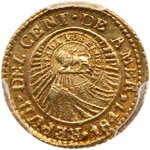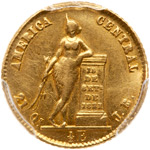
|
Sale 122
June 13-16 Pre-Long Beach Auction
| Lot |
Photo |
Description |
Realized |
Lot 1678 |
 |
Costa Rica. ½ Escudo (1849-57). Fr-5a; KM-80. Weight 0.0450 ounce. Lion type VI Countermark on Central American Republic 1841-JB ½ Escudo (KM-13). PCGS graded AU-58. In special PCGS Ship of Gold holder which contains One Pinch of Gold Dust recovered from the S.S. Central America treasure.
Special PCGS number 674132.58/35474672. Estimated Value $500 - UP
In 1856-1857, Costa Rica was heavily involved in the Filibuster War against the American adventurer William Walker. He had intervened in the Nicaraguan civil war of 1855 and by 1856 had established himself as president of Nicaragua. Juan Rafael Mora, the president of Costa Rica declared war on Walker and his filibusters (foreign mercenaries), who had mounted a failed invasion of Costa Rica in March 1856. The filibuster forces were repelled after a 14-minute battle at Santa Rosa and in April, the Costa Ricans responded by entering Nicaragua and inflicting a major defeat on the filibusters at Rivas. Unfortunately, while this action brought Rivas under Costa Rican control and forced Walker to flee, the victors were decimated by an outbreak of cholera, which was subsequently brought home to Costa Rica. The remainder of 1856 was spent campaigning on the San Juan River in order to seize it from Walker and prevent him from using it and the steamers of the Transit Company to acquire additional weapons and men. By January 1857, Costa Rican forces had full control of the river and its fleet of steamers, thereby strangling Walker's supply line and creating the opportunity for the Septentrión Army of the Central American allies to force the adventurer to surrender to the U.S. Navy and return to the United States. For his role in the conflict, Mora was hailed a Central American hero, but the high cost in money and lives-especially from the cholera outbreak-turned public opinion against him and in 1859 he was overthrown in a coup.
View details and enlarged photos
Realized
$3,120 |
|
Lot 1679 |
 |
Costa Rica. ½ Escudo,1850-JB. Fr-10; KM-97. Weight 0.0450 ounce. Indian woman leaning against column. Reverse; Coat of arms. PCGS graded AU-53. In special PCGS Ship of Gold holder which contains One Pinch of Gold Dust recovered from the S.S. Central America treasure.
Special PCGS number 675687.53/35671940. Estimated Value $500 - UP
In the aftermath of the Spanish defeat in the Mexican War of Independence (1810-1821), Costa Rica and Nicaragua together became an autonomous province within the new Federal Republic of Central America. However, rising tensions and open civil war between the constituent members of the Federal Republic led to its disintegration in 1838 and the establishment of the Free State of Costa Rica under the dictatorial head of state Braulio Carrillo. He fostered a diplomatic relationship for Costa Rica with Great Britain and opened its markets to Costa Rican coffee exports, but was overthrown in 1842 by Francisco Morazán, the former president of the Federal Republic of Central America who hoped to use Costa Rica as a base for reestablishing the federation. However, later the same year, Morazán was deposed and executed in a popular uprising spurred by fear of a looming war with Nicaragua. Following a series of subsequent failed heads of state and a successful coup led by José María Alfaro Zamora, in 1847 a new constitution was enacted to terminate the Free State of Costa Rica and its heads of state and establish the First Republic of Costa Rica with its presidency.
This half escudo was struck only two years after the Republic of Costa Rica was founded. At the time Juan Rafael Mora Porras had begun his first term as president (November 26, 1849-August 14, 1859) and was beginning to introduce policies that would modify the Constitution of 1847. Whereas voting rights had previously been granted to any man born in Costa Rica who had reached legal age, a new wealth requirement was introduced that effectively prevented the great majority of Costa Ricans from having a say in their elections. This development had dire consequences for poor farmers and landless peasants who were already suffering from the privatization of the commons and now lacked any means of gaining any political representation to aid them in their plight.
Interestingly, while the obverse shield design of this coin proclaims the young Republic of Costa Rica, the reverse type is a curious relic of the defunct Federal Republic of Central America. Not only does the legend name Central America, but it depicts a female personification of the region leaning against a pillar inscribed with the date of the Act of Independence of Central America (September 15, 1821), rather than the date of the creation of the Republic of Costa Rica.
View details and enlarged photos
Realized
$1,740 |
|
Lot 1680 |
 |
Costa Rica. ½ Escudo,1855-JB. Fr-10; KM-97. Weight 0.0450 ounce. Indian woman leaning against column. Reverse; Coat of arms. PCGS graded MS-63. In special PCGS Ship of Gold holder which contains One Pinch of Gold Dust recovered from the S.S. Central America treasure.
Special PCGS number 674279.63/35474739. Estimated Value $500 - UP
In 1855, the Republic of Costa Rica was led by the conservative president Juan Rafael Mora, who was two years into his second term. This was a particularly dangerous year for Costa Rica, because a civil war broke out in neighboring Nicaragua between members of the Legitimist and Democratic political parties. Although Mora managed to avoid becoming immediately entangled in the Nicaraguan conflict, the situation changed drastically when the failing Democratic cause sought private American military assistance. Francisco Castellón, the embattled Democratic president of Nicaragua, awarded a contract to the San Francisco-based soldier of fortune William Walker to sail to Nicaragua with 300 "colonists." Upon his arrival in early summer of 1855, Walker crushed the Legitimists with a force of 160 Americans and 170 Nicaraguan Democrats, thereby paving the way to become the de facto ruler of Nicaragua. These developments were cause for great alarm in Costa Rica as Walker made no secret of his desire to conquer all of the states of Central America and annex them to the United States. These tensions, combined with Juan Rafael Mora's staunch opposition to Walker's interference in the region, resulted in the outbreak of the Filibuster War (1856-1857). The Filibuster War ultimately saw Costa Rica and a coalition formed by Honduras, El Salvador, and Guatemala drive Walker and his mercenaries out of Central America although they caused great damage to Nicaragua before they left.
View details and enlarged photos
Realized
$4,080 |
|
|
|